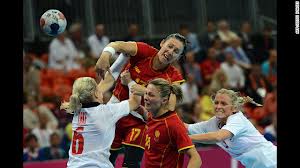You may recall that my main reaction to the men’s handball competition was one of disappointment. Unfortunately, I must say very much the same thing about the women’s tournament. In fact, the similarities are quite amazing. The 2008 champions, on the women’s side Norway, managed to defend the title without really impressing anyone while doing so. Just like in the case of the men, it happened because none of the other team’s showed their normal strength, which would have been enough to deserve to win and to manage to do so. Just like the French men, the Norwegian women were on their way to disaster in the quarterfinal, but their opponents kindly let them off the hook!
The main difference was perhaps that the final for the women had more real drama and excitement, in comparison with the men. Once they managed to qualify for the final, it was not surprising that the team from Montenegro would put up a real fight for the gold. In fact, they were a bit unlucky in losing the final, and it is my background in refereeing that inhibits me when it comes to explaining why I think so… Women’s handball in Montenegro is perhaps the best parallel to men’s handball on Iceland. The population is twice that of Iceland, moving towards 700.000, but the pool of talented handball players is small.
The focus in Montenegro is on team sports, but football and basketball are clearly ahead of handball, and even volleyball is a strong rival for athletes and spectators. But in recent time it is handball that has given the headlines. Buducnost won the EHF Champions League just a few months ago, and now Bojana Popovic, their perennial world-class player led them to the silver in the final match of her career. She had previously won World Championship bronze with Yugoslavia in 2001 and five earlier Champions League titles for Danish clubs. Montenegro hardly looked like a team for the final in the early going. They lost to both Brazil and Croatia, before they managed to tie Russia. But the breakthrough came in the quarterfinal, where they knocked out the equally tough and combative French team, one of the favorites.
The Koreans are always giving priority to the Olympic Games, so they tend to build up their team in four-year cycles. This time, the team showed many of their traditional strengths in terms of speed, energy and tenacity. But somehow they never looked as sturdy as their colleagues from the past, so their style combined with injury problems seemed to make them run out of steam after they knocked out Russia in the quarterfinals. Talking about Russia, their veteran coach Trefilov urged them on during the games in his well-known loud and ‘desperate’ style. But this time his team did not respond to his emotions and efforts. At times they seemed to play in ‘autopilot’ fashion, without their usual spark. So Trefilov was bitter afterwards, announcing his retirement and predicting a bleak future for Russian women’s handball. Indeed, handball is a much more modest sport at the national level in Russia than their international achievements over the years would suggest.
The Spanish team never looked like a candidate for the gold. They were solid and consistent, just as their performances in recent years have suggested, with a third and a fourth place in the 2011 and 2009 World Championships. But there seems to be some ingredient missing that would get them to the top. By contrast, Brazil lived up to the expectations that they might be the ‘dark horse’ this time. They had the advantage of fielding a team that has been playing together for a while now, also through the agreement with the Austrian club team Hypo. They seemed ready and determined to battle for a medal and the performance in group play was impressive. While they lost to Russia, the wins against Croatia and Montenegro were enough to put them at the top of the group standings. They appeared to be riding this wave initially in the quarterfinal, having an amazing 15-9 lead against Norway after about 38 minutes. But it seems they got carried away, suddenly feeling too confident and losing concentration. After too many mistakes and a seemingly casual attitude, they lost the game they almost had won.
Finally, before the event, one of the discussions involved the lop-sided draw resulting from the strange seeding. Who would be the two teams, among six strong ones, who would not make the quarterfinals from the ‘group of death?’ Not so unexpectedly, this fate was shared by Denmark and Sweden. In the past year, Denmark’s women had suddenly but clearly come down from their traditional level, missing out on a medal in 2011 and not being very impressive in the preparation games this year. Sweden got a direct path to London, not because of their performance in 2011 but as runner-up in EURO 2010. But there were doubts about their team strength that now became confirmed. It seems that Sweden may need to rely on reinforcements from a new crop of talents, the winners of this year’s junior world championships.
